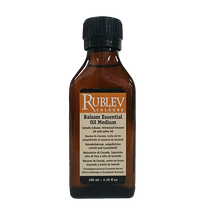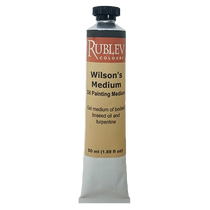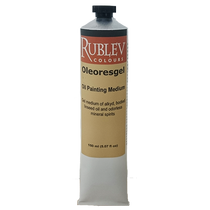Rublev Oil Medium Canada Balsam (250ml) is a traditional oil painting medium made from Canada balsam, pale-bodied linseed oil, and lavender spike oil. This historic formula enhances color brilliance, increases gloss, and improves the fusion of brushstrokes, giving paintings an enamel-like, glowing quality.
When added in small amounts, Canada Balsam Medium makes oil paint brush out more smoothly, adhere better between layers, and dry faster. It is particularly effective for glazing, producing a luminous depth and silky handling that artists have prized since the Old Masters. Mixed directly into paint, it creates a flowing consistency while drying to a satin-to-gloss finish, depending on proportion used.
Canada balsam, obtained from the resin of the balsam fir tree (Abies balsamea), is clearer and faster-drying than Venice turpentine and does not crystallize with age, ensuring stable optical properties. Combined with pale linseed oil for flexibility and spike oil for historical authenticity, this medium provides excellent leveling, flow, and adhesion.
Rublev Canada Balsam Medium is also a reliable substitute for Ralph Mayer’s glazing medium (stand oil, damar varnish, and turpentine) described in The Artist’s Handbook of Materials and Techniques. Supplied in a 250ml bottle, it is an essential addition to the Rublev Natural Pigments range—trusted worldwide and now available in Australia.














